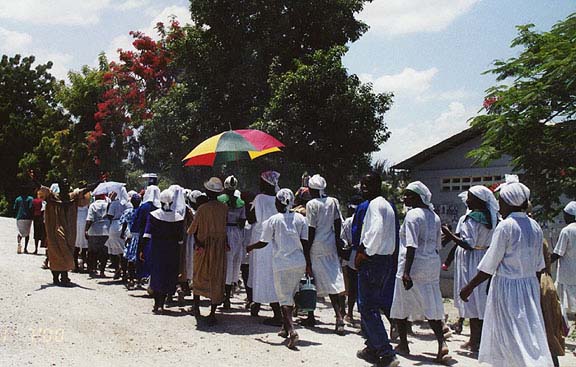
River of screams by Peace Corps Volunteer David Doherty in Haiti
David Doherty, Peace Corps in Haiti
David Doherty is a refugee from all things functional or organized. In other words, he is a Peace Corps volunteer serving in Haiti.
Monday | Tuesday | Wednesday | Thursday | Friday
Friday, 12 Dec 2003
CAMP PERRIN, Haiti.
Haitian proverb: Lavalas pa janm brote sa Bondye sere pou ou.
"The great flood never carries away what God has in store for you."
River of screams.
Peace Corps has a color-code system to warn volunteers about impending risk or danger. Certain areas of the country are always considered Code Red. (These are prone to spontaneous acts of political activity or violence and include Cite Soleil, the largest slum in Port-au-Prince, and the city of Gonaives in the Artibonite.) In the case of hurricane or natural disaster, code colors are assigned and transmitted via a human contact tree system.
Last Friday, a Code Yellow alert went out due to the threat of heavy rains from Tropical Storm Odette and all Peace Corps volunteers in her path were put on evacuation notice.
My town, Camp Perrin, is located on the Ravine du Sud. For much of the year, the river flowing through it is sufficiently narrow and calm to ford by foot. However, during heavy storms in the mountains, the character and the demeanor of the river undergoes a Mr. Hyde-like metamorphosis. There is no tree or ground cover to hold or even slow the progression of rainwater down the hillsides and into the ravine. With little notice, the Ravine du Sud becomes a killing ground.
The commercial part of town bears the brunt of raging floodwaters that spill over the gabions paid for with U.S. AID money. Bowling ball-sized rocks and other debris tear through the streets and fill the canal system; they must later be removed using simple hand tools. The main reason flood-control measures have failed to have any effect is a matter of simple physics. In the past 15 years, floods have deposited enough rocks and other material to raise the riverbed a startling eight feet. As a result, the main road and all of the buildings in the Amba-kan ("under camp") section are now sitting below water level.
Get off the bus.
The town was a victim of two floods in 2002. In May of that year, 23 people were killed and 379 persons displaced. The September flood was less costly in terms of human life, but many more houses were lost as well as the only footbridge crossing the river. The only solution is to move every resident off the flood plain. (As the U.S. Army Corps of Engineers learned the hard way after 100 years, rivers will go where they want to go.) Unfortunately, the government of Haiti lacks the will or the means to effect this change.
The same team that collaborated on the school design (see Monday's entry) has been working with a local group of young entrepreneurs called AJEC. Their plan is to relocate the 30 most at-risk families (217 people) to new homes on higher ground. You can read more about that project as well as the floods of 2002 on the ORE website.
I hope some of you found these brief reports from Haiti interesting if not informative. I've enjoyed writing about my new home. Given the media coverage of Haiti in the mainstream press, most folks think that this country is a lost cause devoid of any hope. Perhaps post-colonial history supports that contention. All I know is that every day when I see the smiles on Haitian children, I find new reasons to keep trying. It may sound a bit hokey, but I believe that no situation is hopeless until the last person gives up hope.
